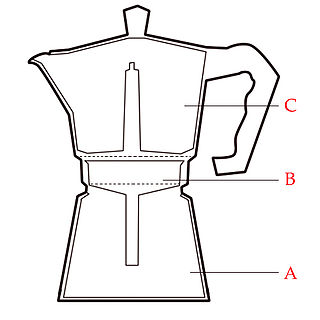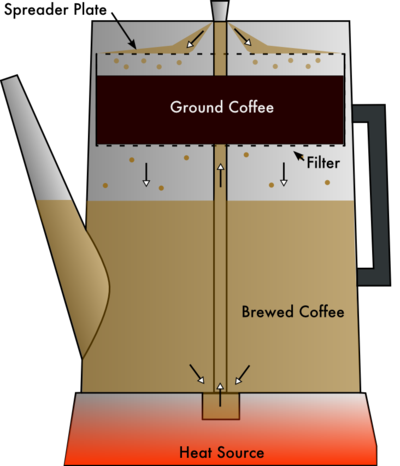Talk:Coffee percolator
Image - straw poll
- Two images were created independently of a cross-section of a moka/percolator coffee pot. As we can't decide ourselves which to post, I thought it would be best to have a quick straw-poll — Asbestos | Talk 20:56, 5 Jun 2005 (UTC)
- For the record, Image '2' was created in May 2004 by VampWillow and has been on the article since then without any complaints. Image '1' was created this weekend by Asbestos although he noted "Had I realized, I wouldn't have made another image, since your diagram is fine" after realising he had created an image that already existed. It is clear though that the comments of other editors may be useful in deciding whether the change is warranted. --Vamp:Willow 21:06, 5 Jun 2005 (UTC)
 |
 |
Image 1
- I believe the first is a cleaner, more accurate (it was precisely measured), and more professional-looking image, making the over-all article look more professional. If necessary, the spouts can easily be made hollow (if this is VampWillow's main objection), though this way is a standard style. — Asbestos | Talk 20:56, 5 Jun 2005 (UTC)
- I also think this version is more professional-looking, so it has my vote. The older image is fine, but a lot more concerns me about it. I'd suggest two changes to the new image, though:
- The labels blend into the image a bit; use colour to make them stand out a bit, but don't make them too gaudy.
- The base can be flattened out; I assume you traced it from a photograph, in which case perspective would've lead to the rounded base as it is now.
- Oh, and hollow spouts would help :) Dewet 03:49, 6 Jun 2005 (UTC)
- Done - you may have to refresh the chache to see the new version. Older versions can be seen at commons:Image:MokaCoffeePot.jpg. — Asbestos | Talk 10:23, 6 Jun 2005 (UTC)
- I'm not going to revert theses flag could I suggest that you reinstate the image you asked people to vote on instead of making repeated edits. Thankyou. --Vamp:Willow 12:55, 8 Jun 2005 (UTC)
- Huh?? I'm utterly confused. Is our object to produce the best picture for an article, or to somehow "win" this vote? Personally, I'm up for producing the best picture for the article. If someone suggests a change, of course I'm going to change it. I'm not going to leave a sub-standard image up if a better one could be made — how does that help the article? Likewise, when I make a diagram for someone who requests it, if they have criticisms I listen to them and edit the picture. Our motivation here, in producing images and calling votes, should be for the best of the article, not to stroke our own egos. Why should you object if I improve my image? If you improve your image and people vote for your improved version, then that will merely mean that your new version is best for the article, and the article will be better off for it. Your "do not edit" flag example is disengenious: when a user puts an article up on VFD, they don't complain if the article subsequently gets improved during the vote — the purpose of any vote is to improve Wikipedia, and if someone suggests how an article or image should be improved during the vote, so much the better. — Asbestos | Talk 13:20, 8 Jun 2005 (UTC)
- Don't take this personally, VampWillow. I have to agree with Asbestos on this one; his image is technically and aesthetically superior, no matter how you look at it. I'm sure that he meant no offence by creating another one, so please take this in the spirit in which Wikipedia is offered: to better human knowledge all around. Dewet 20:34, 8 Jun 2005 (UTC)
- I'm not going to revert theses flag could I suggest that you reinstate the image you asked people to vote on instead of making repeated edits. Thankyou. --Vamp:Willow 12:55, 8 Jun 2005 (UTC)
- I think image one is nicer and more accurate. Madd4Max 12:36, 8 Jun 2005 (UTC)
- I'd go for image 1. 199 23:08, 12 Jun 2005 (UTC)
- I prefer image 1 too as it looks a lot more professional... but how about altering it so that the water/steam paths can be seen (like image2)? Would be just a quick erase of a few pixels :) Mat-C 04:44, 11 July 2005 (UTC)
Image 2
- Basically because it is less cluttered, and it an actual cross-section. Also it clearly shows that the central spouts up and down in the middle are hollow (to let water and coffee through) whereas the image 1 hasn't any clear way through!. Vamp:Willow 21:01, 5 Jun 2005 (UTC)
- Image 2 is much clearer.
Results
Straw polls are informal and thus never officially "end", but is it agreed that there is a consensus to use image 1? — Asbestos | Talk 01:33, 16 July 2005 (UTC)
- I've replaced the image. — Asbestos | Talk 13:24, 18 July 2005 (UTC)
Usage
Percolators are often popular among campers and other outdoorsmen due to the ability to make coffee without a heat source.
You mean without electricity, not a heat source, right?
Naming Convention
There is an empty head on naming convention which is a bit of a shame. The 'Moka stove top' is not called a percolator by everyone. If you go to a coffee shop asking for coffee for a percolator the tender will think you'll want a course ground coffee. I think this article should be split.
---(above comment unsigned)
There is a Moka pot article already. And you are quite correct that a Moka is not a percolator. Percolation is a recirculating drip-brew process: high-pressure water is never forced through the coffee. Moka brewing is a single-pass pressure process. If no one is going to be offended, I'll fix the article to be technically correct.
Sehr Gut 18:20, 25 June 2007 (UTC)
Okay, I reworked the article to conform to accepted definitions of brewing methods as defined by organizations such as the Specialty Coffee Association of America [1].
Sehr Gut 18:45, 25 June 2007 (UTC)
where is it in widespread use?
"the moka pot is the most popular way of brewing coffee at home, and its usage has spread to the USA."
eh? in sweden you can buy a moka pot in every ikea store and in a lot of the regular convenience stores for about 15 euros... i think that comment on how people in north america (if in the us of a then probably in canada too or?) has adopted the use of the moka pot is pretty irrelevant since it is used as much elsewhere (my estimate).
regards -mats
The moka pot is in widespread use in Eastern Europe, and as I remember, it was in common use in Italy in 1980 (last time I was there). When Eastern Europeans relocate to the USA, they usually hate the coffee (not strong enough), and go out of their way to find a moka pot. Or they make Turkish coffee, which is an acquired taste, even for them.
In my personal experience, I bought a gravity-type perk pot for $12 at an "Antique Mall" type of place, and learned to use it. It makes the best coffee I've ever tasted. It's not strong enough for Eastern Europeans, but nice, sweet, non-sour, non-bitter, smooth coffee. It's coffee that tastes as wonderful as it smells.
The downside is that it takes some getting used to. It comes to a full boil (and spills a little from the spout) in 7 minutes on high heat. And it perks nicely at med-low heat (3 1/2 out of 10 settings on my electric stove). If you let it perk a long time, it will get stronger, but not as strong as a moka pot. You can set the stove to "Simmer" and it will stop perking, and keep the coffee warm.
The pot itself is made of enamel, the perking tube, of cast iron maybe (something black and rough), and the coffee grounds basket is made of plastic. The perking indicator is of course heavy glass. I've added a picture to the Wikipedia entry (it's my own pot and I took the picture).
Another tricky thing is to get the coffee grounds large enough to not cause "crunchy coffee." Buzz them no more than 5 seconds in a coffee grinder, or better yet, grind the coffee in one of those adjustable machines you can find in supermakets. No pre-ground coffee will have the right texture for perk pots anymore because the plastic basket's holes are just too large.
71.161.218.115 01:25, 13 April 2007 (UTC)
Coffee machine?
Coffee machine redirects here, but they are totally different. A slot machine that pours a plastic cup of something vaguely coffee-like when you put money in is not a percolator. Any ideas for a better redirect target? Totnesmartin (talk) 22:26, 22 November 2007 (UTC)
- Found one - Vending machine Totnesmartin (talk) 13:54, 8 January 2008 (UTC)
Criticisms?
How about a section on how Percolators are viewed today? I have many coffee junkie friends who say they burn the coffee over and over and makes for a very bad cup of joe. --70.167.58.6 (talk) 05:32, 1 June 2008 (UTC)
Response to Diagram Request
I have made a simple diagram of a percolator. Here it is:

I first attempted to upload it in SVG format, but it wouldn't render properly, so I uploaded it in PNG. I believe it is accurate, but I would like someone else to check.
--UnknownFerret (talk) 17:57, 18 June 2008 (UTC)
Coffee percolators
Bold textI bought a leather box in a yards sales in 2003. It contained an electric percolator, 4 plastic cups, 4 spoons, a can of MJB coffee, a jar of coffe-mate creamer that had "new" on it, and an envelope with a key in it. This envelope had "your transworld holiday key from Hudson Pacific, Santa Monica, Calif" on it. I am trying to find a date for this box. It looks old. I figure 40s or 50s. Does anyone know how I can obtain info on it??? —Preceding unsigned comment added by Taina929 (talk • contribs) 03:32, 13 August 2008 (UTC)
Some quetions
Hot water is less dense then cold, is that effect used at all? Does the hot coffee stays in a layer on top of the colder water, or does it just get mixed?
Where is the water/coffee heated, only in the bottom chamber or the hole bottom?83.188.230.104 (talk) 19:26, 6 October 2008 (UTC)
